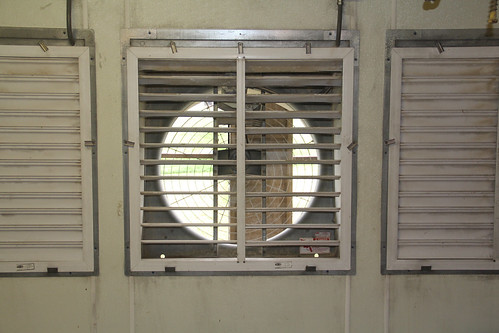Summer prep for poultry houses: Focus on cooling systems
May 18, 2018
By Sarah Cato
U of A System Division of Agriculture
Fast facts:
- Cooling systems essential to poultry production in the South
- Tunnel-ventilated poultry houses must be prepared for summer
- Patching holes, cleaning fans all necessary
(820 words)
(Newsrooms – with downloadable art here: https://flic.kr/s/aHsmi7tnDM )
Download Word version
LITTLE ROCK – Summer in the South is hard on people and harder on poultry, which is why poultry producers should be focusing on their cooling systems as temperatures climb, say poultry experts for the University of Arkansas System Division of Agriculture and Mississippi State.
“In order to provide a cool house for the summer, every component of a tunnel-ventilation system must be in tip-top shape,” said Yi Liang, associate professor-biological and agricultural engineering, for the University of Arkansas System Division of Agriculture. “This starts with the tunnel fans and making sure they’re clean.”

“Fan shutters and blades should be cleaned between flocks,” she said. “Dirty shutters make it harder for the fans to move air and can reduce air moving capacity by 20 percent or more.”
Liang, Thomas Tabler, Mississippi State extension professor of poultry and Dustan Clark, extension poultry veterinarian for the Division of Agriculture urged producers to ensure that all tunnel ventilation system components: fans, belts and even the walls and ceilings of the poultry barns, were in top condition.
Loose belts mean lower RPM
“Fans with loose belts run at an RPM that’s 10-20 percent lower than those with tight belts, leading to lower airflow rates,” Liang said. “Check the riding position of the belts for signs of wear. A worn belt that rides slightly lower in a pulley is similar to using a pulley that is one half inch smaller in diameter, which results in low RPM of fan blades.”
To tell if you have a worn fan belt, check to see where the belt rides.
“The top of the belt should ride slightly above the top of the fan pulley,” she said. “A worn flat belt will drop down into the pulley so that the top of the belt can’t be seen in the pulley.”
Tight ship
The three said another pre-summer task for poultry producers was to ensure a “tight house.” The list of checklist items includes:
- Checking dropped ceilings for holes. Check the static pressure in the poultry house by closing the tunnel curtains or doors and air vents. Turn on one tunnel fan and measure the resulting pressure. The ideal measurement is .20 inches. The minimum, especially in older houses, should be .13 inches. If below .10 inches, hot air can get pulled into the house through the cracks, making it hard to cool the birds.
- Cleaning the evaporative cooling pads. The pads should be free of cobwebs and mineral buildup. Dirty pads can increase the static pressure that works against the fans, forcing the fans to work harder. Be sure to check the air speed in the center of the pad system with all tunnel fans running. For a 6-inch pad, the air speed should be 350-400 feet per minute; for a 4-inch pad, the air speed should be 225-275 feet per minute. “If your speeds are higher than what’s listed, either more cleaning needs to be done, or you may not have enough pad to match your full tunnel ventilation,” the three said.
- Change water. After turning off the water supply, empty the reservoirs. Sump water needs to be changed every two to three weeks to reduce mineral buildup and minimize algae growth. Make sure valves and filters are cleaned and check the spray height at the end of the water distribution system.
- Clean filters. Clogged filters will add pressure to the pump, reducing flow rate to distribution lines. The extension experts suggest decreasing mesh size to a 20 or 12 to reduce head pressure.
For more information on prepping your tunnel ventilation systems for this summer, contact your county extension office or visit www.uaex.uada.edu.
About the University of Arkansas System Division of Agriculture
The University of Arkansas System Division of Agriculture’s mission is to strengthen agriculture, communities, and families by connecting trusted research to the adoption of best practices. Through the Agricultural Experiment Station and the Cooperative Extension Service, the Division of Agriculture conducts research and extension work within the nation’s historic land grant education system.
The Division of Agriculture is one of 20 entities within the University of Arkansas System. It has offices in all 75 counties in Arkansas and faculty on five system campuses.
The University of Arkansas System Division of Agriculture is an equal opportunity institution. If you require a reasonable accommodation to participate or need materials in another format, please contact your county extension office as soon as possible. Dial 711 for Arkansas Relay.
# # #
Media Contact: Mary Hightower
Dir. of Communication Services
U of A System Division of Agriculture
Cooperative Extension Service
(501) 671-2126
mhightower@uada.edu